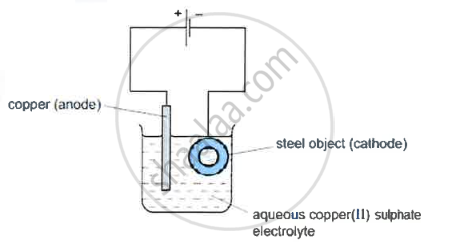Advertisements
Advertisements
Question
Mr Ramu wants electrolyte his key chain with nickel to prevent rusting. For this electroplating
(i) Name the electrolyte
(ii) Name the cathode
(iii) Name the anode
(iv) Give the reaction at the cathode
(v) Give the reaction at the anode
Solution
(i) Aqueous solution of nickel sulphate with few drops of dil. sulphuric acid
(ii) Article (e.g. key chain)
(iii) Pure nickel
(iv) Ni2+ + 2e-→ Ni
(v) Ni → Ni2+ + 2e-
APPEARS IN
RELATED QUESTIONS
Identify the substance underlined, in the following case
The electrolyte used for electroplating an article with silver.
Name the following :
The process of coating of iron with zinc
Give reasons why In the electroplating of an article with silver, the electrolyte sodium argentocyanide solution is preferred over silver nitrate solution.
An electrolytic cell is set up using two platinum electrodes and an aqueous solution of copper (II) sulphate,
(a)draw a labelled diagram of the electrolytic cell,
(b)Name the ions present in the cell,
(c)Name the ions migrating towards the anode,
(d)Name the ions migrating towards the cathode,
(e)Name the ions which will not be discharged at electrodes during electrolysis,
(f)Write the reaction at the cathode,
(g)Write the reaction at the anode,
(h)Name the spectator ion in the solution.
State the electrode reaction at the anode during electrolysis of:
Aqueous copper sulphate solution.
Give reason for the following:
For electroplating with silver, silver nitrate is not used as an electrolyte.
List out the main applications of electrolysis.
The following question relate to the electroplating of an article with silver.
What should be the nature of the anode?
What ions must be present in a solution used for electroplating a particular metal?
Electroplating steel objects with silver involves a three-step process.
Step 1: A coating of copper is applied to the object.
Step 2: A coating of nickel is applied to the object.
Step 3: The coating of silver is applied to the object.
-
- A diagram of the apparatus used for step 1 is shown

- The chemical process taking place on the surface of the object is \[\ce{Cu^2+(aq) + 2e- ->Cu(s)}\]
What is the observation seen on the surface of the object? - Explain why the concentration of copper ions in the electrolyte remains constant throughout step 1.
- The chemical process taking place on the surface of the object is \[\ce{Cu^2+(aq) + 2e- ->Cu(s)}\]
- A diagram of the apparatus used for step 1 is shown
- Give two changes which would be needed in order to coat nickel on to the object in step 2.
- Write down the reaction taking place at the positive electrode during step 3.
